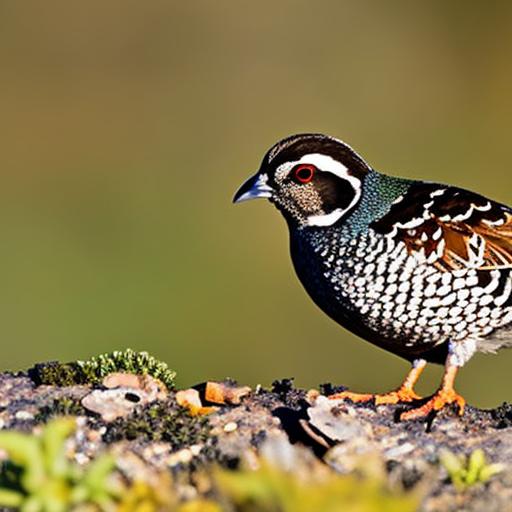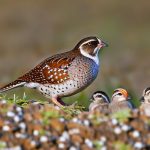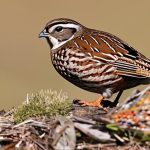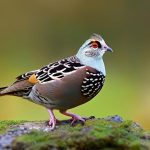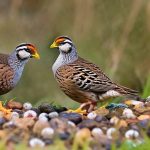Harlequin quail, also known as Chinese painted quail, are small, ground-dwelling birds that are native to Southeast Asia. They are popular among bird enthusiasts for their colorful plumage and charming personalities. Harlequin quail are known for their distinctive markings, with the males sporting a striking blue-gray head and chestnut-colored body, while the females have a more subdued brown and cream coloring. These birds are relatively easy to care for and make great pets for those who have limited space or live in urban areas.
Harlequin quail are social birds and are best kept in small groups, as they thrive on companionship. They are also known for their gentle and docile nature, making them a great choice for families with children. These birds are also relatively quiet, making them suitable for apartment living. With the right care and attention, harlequin quail can live up to 5 years in captivity, providing their owners with years of enjoyment and companionship.
Key Takeaways
- Harlequin quail are small, colorful birds native to Africa and are popular for their unique appearance and low maintenance.
- When housing harlequin quail, it’s important to provide a spacious enclosure with plenty of hiding spots and soft bedding material.
- A balanced diet for harlequin quail includes a mix of seeds, grains, and fresh greens, along with access to grit for digestion.
- Regular health check-ups and access to a qualified avian veterinarian are essential for maintaining the well-being of harlequin quail.
- Breeding harlequin quail requires careful monitoring of nesting behavior and providing a suitable environment for egg laying and chick rearing.
Housing and Enclosure Requirements
When it comes to housing harlequin quail, it’s important to provide them with a suitable enclosure that meets their specific needs. A spacious cage or aviary is essential, as these birds require plenty of room to move around and exercise. The enclosure should be at least 24 inches long and 12 inches wide per pair of quail, with a minimum height of 12 inches. It’s important to provide a secure enclosure with a solid bottom to prevent the quail from escaping or injuring themselves.
The flooring of the enclosure should be covered with a soft bedding material, such as straw or wood shavings, to provide a comfortable and clean environment for the quail. Additionally, it’s important to provide plenty of hiding spots and perches for the quail to roost on. Natural branches or commercially available perches can be used to create a stimulating environment for the birds. It’s also important to provide a shallow dish of water for bathing, as well as a separate dish for food. The enclosure should be placed in a quiet area away from drafts and direct sunlight to ensure the comfort and well-being of the quail.
Diet and Nutrition
Proper nutrition is essential for the health and well-being of harlequin quail. These birds are omnivorous and require a balanced diet that consists of both seeds and insects. A high-quality commercial game bird feed can serve as the base of their diet, supplemented with fresh fruits and vegetables, such as leafy greens, carrots, and berries. It’s important to provide a variety of foods to ensure that the quail receive all the essential nutrients they need to thrive.
In addition to their main diet, harlequin quail also require access to grit and calcium supplements to aid in digestion and eggshell formation for breeding females. It’s important to monitor their food intake and adjust their diet as needed to prevent obesity or malnutrition. Fresh water should always be available for the quail, as they require regular access to clean drinking water for hydration and overall health.
Health and Veterinary Care
Maintaining the health of harlequin quail is essential for their long-term well-being. Regular health checks by a qualified avian veterinarian are recommended to ensure that the birds are in good condition. It’s important to monitor their behavior and appearance for any signs of illness or injury, such as lethargy, loss of appetite, or abnormal feathering.
Preventative measures, such as regular cleaning of the enclosure and providing a clean and hygienic environment, can help reduce the risk of disease. Additionally, it’s important to quarantine any new birds before introducing them to an existing flock to prevent the spread of illness. Proper hygiene practices, such as washing hands before and after handling the birds, can also help prevent the transmission of disease.
Breeding and Reproduction
Breeding harlequin quail can be a rewarding experience for bird enthusiasts. These birds are relatively easy to breed in captivity, provided that they are given the proper conditions and care. Breeding pairs should be housed in a separate enclosure with plenty of nesting material, such as straw or grass, to encourage breeding behavior.
The female quail will lay eggs in the nesting material, which should be collected and placed in an incubator if breeding is desired. The eggs should be kept at a consistent temperature and humidity level until they hatch, which typically takes around 16-18 days. Once the chicks hatch, they should be provided with a warm and safe environment to grow and develop.
It’s important to provide the breeding pair with a nutritious diet that includes additional calcium supplements for the female during the breeding season to support egg production. Monitoring the breeding pair for any signs of stress or aggression is also important to ensure successful breeding and healthy offspring.
Behavioral Enrichment and Exercise
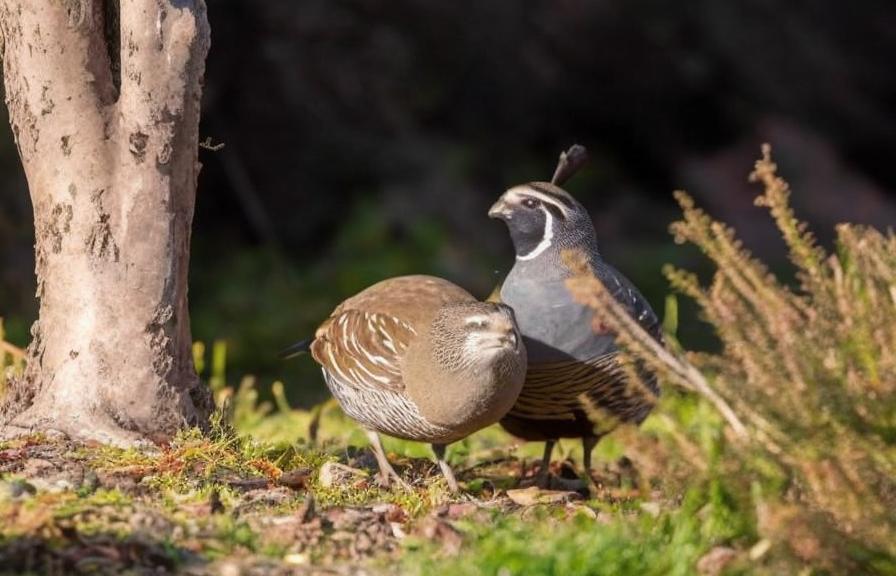
Harlequin quail are active birds that require plenty of mental stimulation and exercise to thrive in captivity. Providing them with toys, such as mirrors or hanging objects, can help keep them entertained and engaged. Additionally, allowing them access to a larger outdoor enclosure or supervised time outside can provide them with opportunities for natural behaviors, such as dust bathing and foraging.
It’s important to provide plenty of opportunities for exercise within their enclosure, such as perches or platforms for climbing and jumping. Regular interaction with their owners can also provide mental stimulation and socialization for the quail. Providing a varied environment with different textures and materials can also help keep them mentally stimulated and prevent boredom.
Tips for Successful Quail Keeping
Keeping harlequin quail can be a rewarding experience when done properly. Here are some tips for successful quail keeping:
1. Provide a spacious enclosure with plenty of hiding spots and perches for the quail.
2. Offer a balanced diet that includes commercial game bird feed, fresh fruits and vegetables, grit, and calcium supplements.
3. Monitor their health regularly and seek veterinary care when needed.
4. Provide a suitable environment for breeding if desired, including nesting material and a separate enclosure.
5. Offer plenty of behavioral enrichment and exercise opportunities to keep the quail mentally stimulated.
6. Practice good hygiene practices to prevent disease transmission.
7. Monitor their behavior and adjust their care as needed to ensure their well-being.
By following these tips and providing proper care and attention, harlequin quail can thrive in captivity and provide their owners with years of enjoyment and companionship.
If you’re interested in keeping harlequin quail, you may also want to learn about the best vegetables for them to eat. Poultry Wizard has a helpful article on what vegetables quails eat, which provides valuable insights into their dietary needs. Understanding the right foods for your quail can contribute to their overall health and well-being.
FAQs
What are harlequin quail?
Harlequin quail, also known as Chinese painted quail, are small ground-dwelling birds native to Southeast Asia. They are popular as pets and for their colorful plumage.
What do harlequin quail eat?
In the wild, harlequin quail primarily feed on a diet of seeds, insects, and small plants. In captivity, they can be fed a commercial game bird feed supplemented with fresh greens and the occasional mealworm or cricket.
How do you keep harlequin quail as pets?
Harlequin quail are best kept in pairs or small groups in a spacious aviary with plenty of hiding spots and places to forage. They require a balanced diet, access to clean water, and a warm, dry environment.
What is the lifespan of harlequin quail?
In captivity, harlequin quail can live for 4-6 years with proper care and a suitable environment.
Are harlequin quail noisy?
Harlequin quail are relatively quiet birds, making soft chirping and cooing sounds. They are considered to be good pets for those who live in apartments or close quarters.
Meet Walter, the feathered-friend fanatic of Florida! Nestled in the sunshine state, Walter struts through life with his feathered companions, clucking his way to happiness. With a coop that’s fancier than a five-star hotel, he’s the Don Juan of the chicken world. When he’s not teaching his hens to do the cha-cha, you’ll find him in a heated debate with his prized rooster, Sir Clucks-a-Lot. Walter’s poultry passion is no yolk; he’s the sunny-side-up guy you never knew you needed in your flock of friends!

